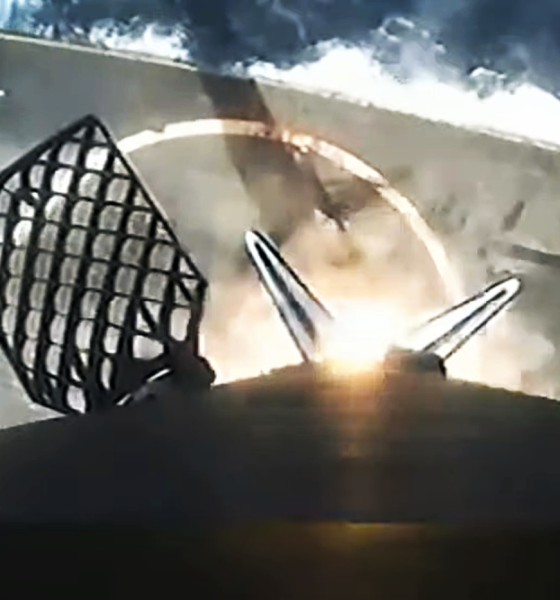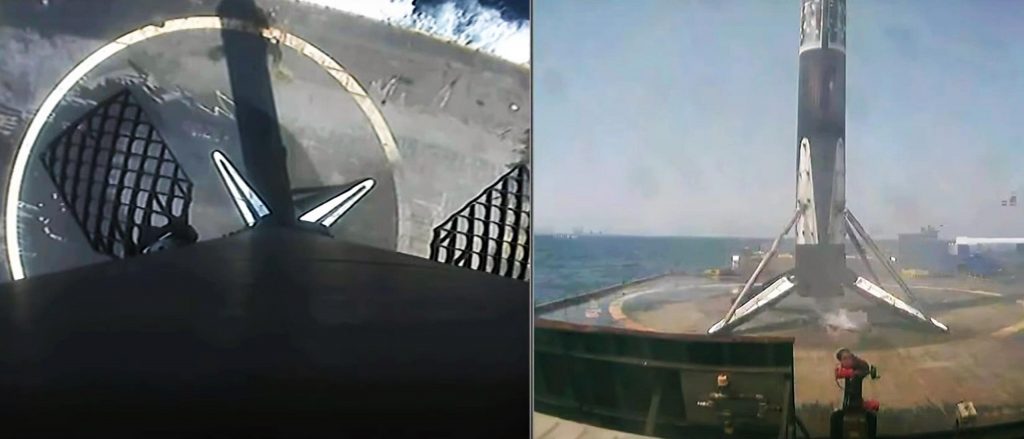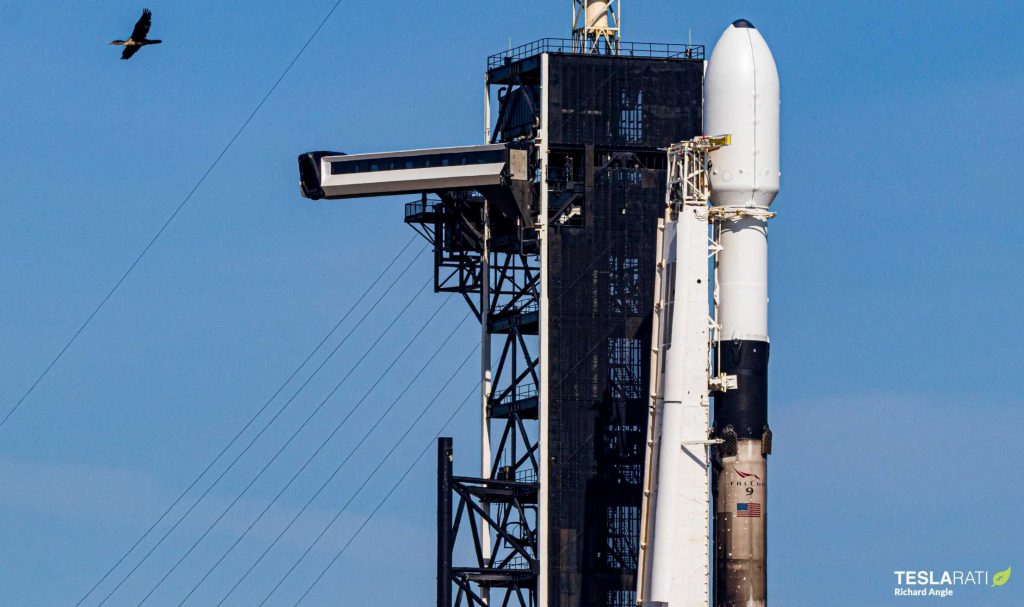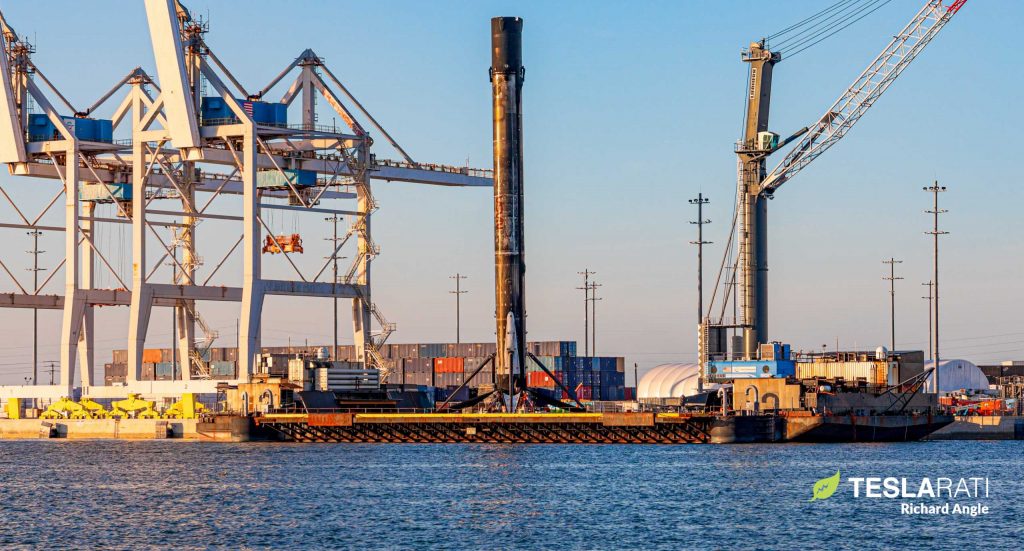

News
SpaceX Starlink launch offers rare live view of Falcon 9 booster landing
Update: SpaceX has aced the first its tenth launch of 2021 and 23rd operational Starlink launch while simultaneously offering an uninterrupted live view of a Falcon 9 booster landing from the rocket’s onboard camera for the first time in months.
While SpaceX’s official webcast got off to a rough start with no onboard camera views throughout the entirety of ascent and beginning of booster descent, whatever was causing the camera outage was fixed around seven minutes after liftoff, returning live onboard views after the first outage of its kind in years. For whatever reason, Falcon 9 booster B1058 and the satellite link it uses to transmit telemetry and live camera views behaved almost perfectly for the next few minutes, providing a nearly uninterrupted two-minute-long view of the rocket’s seventh successful landing.
For unknown reasons, those uninterrupted onboard views may have still been unusual but were substantially less rare a few years ago. Over the last several-dozen SpaceX Falcon launches, they’ve effectively faded into a once-in-a-blue-moon occurrence. Regardless, Falcon 9 B1058 has become the second SpaceX booster ever to fly twice in less than four weeks, falling just four hours short of setting a new turnaround record for reusable rockets.


45 minutes after liftoff, Falcon 9’s expendable second stage relit for a brief one-second burn. Around 20 minutes later, after spinning itself end over end, the rocket commanded the deployment of its batch of 60 operational Starlink satellites, sending the spacecraft on their way to gradually spread apart, deploy solar arrays, and begin propelling themselves to their final orbits. With Starlink-23 complete, SpaceX has successfully launched 10 orbital missions in the first 95 days of 2021, a cadence that would equate to almost 40 launches this calendar year if SpaceX can sustain it.
SpaceX is scheduled to attempt its tenth orbital launch of 2021 – also Falcon 9’s two-dozenth dedicated Starlink mission – as early as 12:34 pm EDT (UTC-4) on Wednesday, April 7th.
Known as Starlink-23 SpaceX’s 23rd dedicated launch of operational Starlink satellites and 24th operational launch overall will also mark the first time a Falcon 9 rocket lifts off under daylight since January 24th – a welcome reprieve after half a dozen late-night or early-morning Starlink launches. SpaceX will offer an official webcast of the launch as usual, with coverage beginning around 12:20 pm at the links below.
In what has rapidly become the company’s default, Starlink-23 will also continue to establish that SpaceX is on track for a record-breaking number of launches this year.
Encapsulating the mission’s stack of 60 Starlink v1.0 satellites to protect them from the environment and the aerothermal stresses of launch, one of Starlink-23’s two fairing halves will be flying for the fourth time – the second of its kind for rocket fairing reusability. The other fairing half supported one other Starlink mission prior to Wednesday’s launch, making it SpaceX’s 15th launch – and Falcon 9’s fifth consecutive launch – with a fully flight-proven payload fairing since the company first began reusing the carbon composite nosecones in November 2019.


Beneath Starlink-23’s flight-proven fairing and expendable second stage, SpaceX has assigned Falcon 9 booster B1058 to the launch. Barring delays, the historic rocket – famous for debuting in May 2020 on SpaceX’s inaugural ‘Demo-2’ astronaut launch – will narrowly miss beating SpaceX’s Falcon booster turnaround record (27d 4h) by a little over four hours. In other words, Starlink-23 will mark the second time in spaceflight history that a rocket booster has flown twice in less than four weeks and achieve that feat just two months after Falcon 9 B1060 became the first to do so.
Beyond individual feats of rocket reuse, Starlink-23 will also be SpaceX’s 10th orbital launch in three months – just 95 days into the new year. On average, that means that the company and its Falcon rockets are on track to complete nearly 40 orbital launches (~39) in 2021 – shy of CEO Elon Musk’s ambitious 48-launch target but still a major achievement if SpaceX can sustain its first-quarter cadence.
After Starlink-23, SpaceX is expected to enter a rare two-week stand-down as it turns its focus to Crew-2, Crew Dragon’s second operational astronaut launch. That mission is scheduled to launch no earlier than (NET) April 22nd.

News
Elon Musk’s Grok AI to be used in U.S. War Department’s bespoke AI platform
The partnership aims to provide advanced capabilities to 3 million military and civilian personnel.

The U.S. Department of War announced Monday an agreement with Elon Musk’s xAI to embed the company’s frontier artificial intelligence systems, powered by the Grok family of models, into the department’s bespoke AI platform GenAI.mil.
The partnership aims to provide advanced capabilities to 3 million military and civilian personnel, with initial deployment targeted for early 2026 at Impact Level 5 (IL5) for secure handling of Controlled Unclassified Information.
xAI Integration
As noted by the War Department’s press release, GenAI.mil, its bespoke AI platform, will gain xAI for the Government’s suite of tools, which enable real-time global insights from the X platform for “decisive information advantage.” The rollout builds on xAI’s July launch of products for U.S. government customers, including federal, state, local, and national security use cases.
“Targeted for initial deployment in early 2026, this integration will allow all military and civilian personnel to use xAI’s capabilities at Impact Level 5 (IL5), enabling the secure handling of Controlled Unclassified Information (CUI) in daily workflows. Users will also gain access to real‑time global insights from the X platform, providing War Department personnel with a decisive information advantage,” the Department of War wrote in a press release.
Strategic advantages
The deal marks another step in the Department of War’s efforts to use cutting-edge AI in its operations. xAI, for its part, highlighted that its tools can support administrative tasks at the federal, state and local levels, as well as “critical mission use cases” at the front line of military operations.
“The War Department will continue scaling an AI ecosystem built for speed, security, and decision superiority. Newly IL5-certified capabilities will empower every aspect of the Department’s workforce, turning AI into a daily operational asset. This announcement marks another milestone in America’s AI revolution, and the War Department is driving that momentum forward,” the War Department noted.
News
Tesla FSD (Supervised) v14.2.2 starts rolling out
The update focuses on smoother real-world performance, better obstacle awareness, and precise end-of-trip routing, among other improvements.

Tesla has started rolling out Full Self-Driving (Supervised) v14.2.2, bringing further refinements to its most advanced driver-assist system. The new FSD update focuses on smoother real-world performance, better obstacle awareness, and precise end-of-trip routing, among other improvements.
Key FSD v14.2.2 improvements
As noted by Not a Tesla App, FSD v14.2.2 upgrades the vision encoder neural network with higher resolution features, enhancing detection of emergency vehicles, road obstacles, and human gestures. New Arrival Options let users select preferred drop-off styles, such as Parking Lot, Street, Driveway, Parking Garage, or Curbside, with the navigation pin automatically adjusting to the user’s ideal spot for precision.
Other additions include pulling over for emergency vehicles, real-time vision-based detours for blocked roads, improved gate and debris handling, and extreme Speed Profiles for customized driving styles. Reliability gains cover fault recovery, residue alerts on the windshield, and automatic narrow-field camera washing for new 2026 Model Y units.
FSD v14.2.2 also boosts unprotected turns, lane changes, cut-ins, and school bus scenarios, among other things. Tesla also noted that users’ FSD statistics will be saved under Controls > Autopilot, which should help drivers easily view how much they are using FSD in their daily drives.
Key FSD v14.2.2 release notes
Full Self-Driving (Supervised) v14.2.2 includes:
- Upgraded the neural network vision encoder, leveraging higher resolution features to further improve scenarios like handling emergency vehicles, obstacles on the road, and human gestures.
- Added Arrival Options for you to select where FSD should park: in a Parking Lot, on the Street, in a Driveway, in a Parking Garage, or at the Curbside.
- Added handling to pull over or yield for emergency vehicles (e.g. police cars, fire trucks, ambulances).
- Added navigation and routing into the vision-based neural network for real-time handling of blocked roads and detours.
- Added additional Speed Profile to further customize driving style preference.
- Improved handling for static and dynamic gates.
- Improved offsetting for road debris (e.g. tires, tree branches, boxes).
- Improve handling of several scenarios, including unprotected turns, lane changes, vehicle cut-ins, and school buses.
- Improved FSD’s ability to manage system faults and recover smoothly from degraded operation for enhanced reliability.
- Added alerting for residue build-up on interior windshield that may impact front camera visibility. If affected, visit Service for cleaning!
- Added automatic narrow field washing to provide rapid and efficient front camera self-cleaning, and optimize aerodynamics wash at higher vehicle speed.
- Camera visibility can lead to increased attention monitoring sensitivity.
Upcoming Improvements:
- Overall smoothness and sentience.
- Parking spot selection and parking quality.
News
Tesla is not sparing any expense in ensuring the Cybercab is safe
Images shared by the longtime watcher showed 16 Cybercab prototypes parked near Giga Texas’ dedicated crash test facility.

The Tesla Cybercab could very well be the safest taxi on the road when it is released and deployed for public use. This was, at least, hinted at by the intensive safety tests that Tesla seems to be putting the autonomous two-seater through at its Giga Texas crash test facility.
Intensive crash tests
As per recent images from longtime Giga Texas watcher and drone operator Joe Tegtmeyer, Tesla seems to be very busy crash testing Cybercab units. Images shared by the longtime watcher showed 16 Cybercab prototypes parked near Giga Texas’ dedicated crash test facility just before the holidays.
Tegtmeyer’s aerial photos showed the prototypes clustered outside the factory’s testing building. Some uncovered Cybercabs showed notable damage and one even had its airbags engaged. With Cybercab production expected to start in about 130 days, it appears that Tesla is very busy ensuring that its autonomous two-seater ends up becoming the safest taxi on public roads.
Prioritizing safety
With no human driver controls, the Cybercab demands exceptional active and passive safety systems to protect occupants in any scenario. Considering Tesla’s reputation, it is then understandable that the company seems to be sparing no expense in ensuring that the Cybercab is as safe as possible.
Tesla’s focus on safety was recently highlighted when the Cybertruck achieved a Top Safety Pick+ rating from the Insurance Institute for Highway Safety (IIHS). This was a notable victory for the Cybertruck as critics have long claimed that the vehicle will be one of, if not the, most unsafe truck on the road due to its appearance. The vehicle’s Top Safety Pick+ rating, if any, simply proved that Tesla never neglects to make its cars as safe as possible, and that definitely includes the Cybercab.








